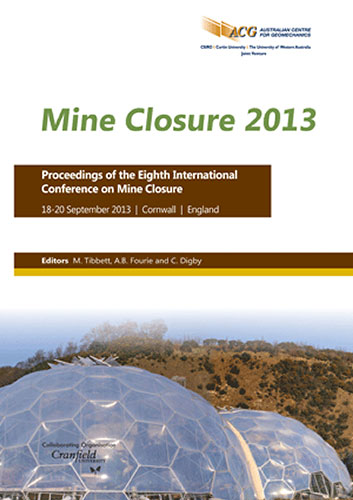Quantifying reactive waste rock distribution in a constructed rock storage facility to achieve effective closure

|
Authors: Scott, PA; Defferard, P Paper is not available for download Contact Us |
DOI https://doi.org/10.36487/ACG_rep/1352_19_Scott
Cite As:
Scott, PA & Defferard, P 2013, 'Quantifying reactive waste rock distribution in a constructed rock storage facility to achieve effective closure', in M Tibbett, AB Fourie & C Digby (eds), Mine Closure 2013: Proceedings of the Eighth International Seminar on Mine Closure, Australian Centre for Geomechanics, Cornwall, pp. 223-237, https://doi.org/10.36487/ACG_rep/1352_19_Scott
Abstract:
Mining of base and precious metal deposits by open pit methods normally results in the removal of significant volumes of waste rock in order to access the ore. The extracted waste rock is commonly placed in an out-of-pit waste rock storage facility (RSF). Modern environmental legislation requires mine waste rock storages to be designed and engineered to contain and isolate the reactive waste rock, to minimise release of acid and metal drainage. During the mine’s life, operating conditions change in response to falling metal prices, higher operating costs, better knowledge of the deposit, change of mine ownership and change or loss of key staff. With these changes, the method of construction of the RSF may need to be modified from the accepted design at commencement of mining. In the absence of construction details, RSFs can be decommissioned using incorrect and inappropriate cover design and water management, resulting in prolonged poor-quality seepage. In such instances, regulatory authorities are becoming increasingly reluctant to accept mine lease relinquishment and release of bond money. Effective closure and rehabilitation of an RSF containing reactive waste rock, typically sulphidic rock, requires an understanding of how it was constructed and where the different waste units, including the reactive waste rock, have been placed. Often the current mine plan is incomplete or insufficient, and knowledge of the construction method for the RSF is not retained by current mining staff. It is, however, possible to identify the makeup or ‘anatomy’ of the RSF using historical mine-generated data to facilitate effective closure of the facility, without resorting to extensive drilling programs. This paper is a case study of three out-of-pit RSFs from a large base metal mine where the construction details were temporarily lost to the current mine operators. The authors were able to collect and collate available data for every year of the mine life, totalling more than 15 years. These data were then assessed using spatial analysis and mine planning software packages to build a model of each RSF that defined and quantified the distribution of reactive and benign waste rock for the 15 years of mine life. The assessment identified where reactive sulphidic waste rock had been placed within each RSF for each year of operation. The existence and extent of reactive waste rock exposed on outer RSF batters and beneath the outer batter slopes were defined. The exposure and duration of exposure of reactive waste rock was also defined to identify potential ‘reaction cells’ with the RSFs that may require specific remediation and management to facilitate closure. The outcome of the study is a better understanding of waste rock type distribution within each RSF. This can be used to enhance closure planning and define final earthworks to contain and mitigate reactive waste rock.
References:
Broadbent, G.C., Myers, R.E. and Wright, J.V. (1998) Geology and origin of shale-hosted Zn-Pb-Ag mineralisation at the Century deposit, Northwest Queensland, Australia, Economic Geology, Vol. 93, pp. 1,264–1,294.
Broadbent, G.C. and Waltho, A.E. (1998) Century zinc-lead-silver deposit, in Geology of Australian and Papua New Guinean Mineral Deposits, D.A. Berkman and D.H. Mackenzie (eds), The AusIMM, Melbourne, pp. 729–736.
Dames & Moore (1994) The Century Project Draft Impact Assessment Study Report, Spring Hill, Queensland.
EGi (1995a) Century Zinc Project Waste Rock – Assessment of Geochemistry and Acid Forming Potential, Consultants Report 1308/222.
EGi (1995b) Century Zinc Project Waste Rock – Leach Column Study of Acid Forming Waste Rock and Effect of Limestone Blending, Interim Consultants Report 1308/223.
EGi (1997a) Waste Rock Geochemistry – Geochemical Characterisation Classification and Scheduling of Waste Rock, Consultants Report.
EGi (1997b) Pasminco Century Project – Waste Rock Geochemistry, Leach Column Study of Potentially Acid Forming Waste Rock and Effect of Limestone Blending, Consultants Report 1308/337.
HLA (2006) South Waste Rock Dump Seepage Investigation – Zinifex Century Mine Lawn Hill, Consultants Report B2002601_RPTDraft_06Nov06_PW.
Kelso, I., Briggs, T. and Basford, O. (2001) The Century Deposit – Geological Update, Australia.
OKC (2011) Century Mine South Dump Cover System Trials – Performance Monitoring Report for the Period June 2007 to May 2011, Consultants Report 732/5-01.
Scott, P. and Lee, G. (2008) Anatomy of a Waste Rock Storage Facility – Quantifying Reactive Waste Rock Distribution in a Constructed Rock Storage Facility, 6th Australian Workshop on Acid & Metalliferous Drainage, ACMER, Burnie, April 2008.
ZCM (2008) Zinifex Century Mine Procedure – Waste Rock Management, Internal document CP-058-00002, v3.
© Copyright 2025, Australian Centre for Geomechanics (ACG), The University of Western Australia. All rights reserved.
View copyright/legal information
Please direct any queries or error reports to repository-acg@uwa.edu.au
View copyright/legal information
Please direct any queries or error reports to repository-acg@uwa.edu.au